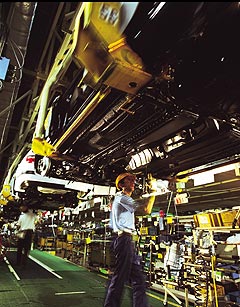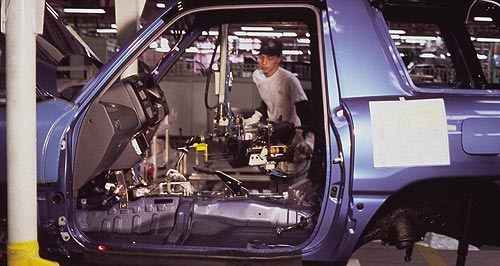News - General NewsQuake fails to stem car flow – for nowSuspended production: A worker in action at Toyota's Motomachi plant. Stockpiled vehicles loaded on to ships for Australia as Japanese industry in limbo15 Mar 2011 JAPANESE-MADE cars are continuing to roll on to ships for Australia, even though the seven biggest motor companies in the earthquake-ravaged country have suspended production while they assess the damage to their factories and supply chains. The flow of vehicles from dockside stockpiles, along with those already on the water, will mitigate against any supply shortages in Australian showrooms, at least in the short term while the industry gets back on its feet. Car companies in Japan are feverishly checking on the state of suppliers in the worst-hit regions of northeast Japan, as well as transport connections and other critical services. The massive Japanese motor industry famously runs on a just-in-time delivery system, which only works when all the required parts are delivered without interruption. Dozens of suppliers have facilities in the danger zone, raising fears that production lines will quickly run out of certain parts and stall the industry. The interrupted power supply is also cause for concern. Vehicle production was suspended on Monday by Toyota, Honda, Nissan, Mitsubishi, Mazda, Subaru and Suzuki so the companies could assess the impact, particularly on suppliers. Australia’s biggest car company, Toyota Australia, has confirmed that vehicles built for Australian customers before the earthquake on Friday are still being loaded on to car carriers at Japanese ports, most of which are unaffected by the earthquake and the resultant tsunami.  Left: Toyota's Motomachi plant. Left: Toyota's Motomachi plant.Deliveries of Camry and Aurion parts for Toyota’s Australian factory at Altona, Victoria, are also continuing, at least for now, assuring that local production will continue for the foreseeable future. Other car companies have also confirmed that at least some deliveries are expected from dockside holding yards in major ports such as Yokohama – Japan’s second biggest port after the Port of Tokyo – which was not damaged in the events of Friday. Car shipping terminals at Nagoya – close to Toyota’s main manufacturing centre at Toyota City – Osaka, Kobe and Hiroshima are also operational. At the latter, Mazda has roll-on shipping facilities adjoining its factory. Toyota Australia public relations manager Mike Breen said Toyota plants would remain closed until Thursday while the situation affecting parts suppliers was being assessed. “The information we have received is they are intending to go back Thursday, although that will need to be confirmed closer to that time,” he said. “There has been no interruption to vessels leaving Japan at this stage. There has been some congestion at the ports, as you would expect, but cars are being loaded.” So far, the factory closures have cost Toyota 40,000 vehicles. Nissan Australia head of corporate communications Jeff Fisher said four Nissan plants in the Tokyo area were due to resume production tomorrow (Wednesday), but two more to the north of the capital and closer to the quake epicentre would remain closed until Friday. Those plants, which suffered some damage in the initial quake, produce vehicles such as the Nissan GT-R and 370Z. “We have adequate stock of GT-R and ‘Z’ here already,” he said. “Further out, it’s too early to speculate. “The bigger challenge, once gas and electricity is restored to the plants, is the condition of our suppliers and infrastructure/communications.” Japan’s second biggest motor manufacturer, Honda, has closed all of its manufacturing facilities and its Tochigi research and development and engineering centres until Sunday, March 20. However, Honda Australia receives 80 per cent of its stock from Thailand. Public relations manager Mark Higgins said that, for now, the company had adequate stocks of Japanese-made models that include Civic Hybrid, Accord Euro, Odyssey, Insight and Legend. In Japan, Honda’s contribution to earthquake relief includes 1000 portable electricity generators. Mazda, whose plants were well away from the danger zone in western Japan, yesterday extended the production suspension at its Hiroshima and Hofu plants until March 20. It previously had hoped to reopen on Thursday. “Mazda will announce any further production changes for March 21 onward as soon as a decision is made,” the company said in an announcement in Japan. Like Toyota, Mazda Australia is expecting little immediate affect on showroom stocks. “Based on current information, the disaster is unlikely to have any major effect on stock supply to Australia in the short term,” the local company said. “Mazda will continue to closely monitor the situation to assess what other effects it may have.” Subaru Australia national corporate affairs manager David Rowley said Subaru’s parent Fuji Heavy Industries had reported no damage to its car factories north-west of Tokyo, and was due to resume production on Thursday. However, he said a statement from Fuji head office indicated a decision to restart production “would depend upon ongoing problems such as electric power outage and parts supply”. Mitsubishi Motors says it has sufficient parts to resume production Wednesday, but cautioned that it would advise if production would continue Thursday. Japan is the largest source of motor vehicles for Australia, delivering 356,000 cars and trucks to Australian customers in 2010 – more than the next two suppliers, South Korea and Thailand, combined. Most of the Japanese motor industry is clustered south of the danger zone, although Toyota has manufacturing facilities in Miyagi Prefecture – one of the worst-hit areas. These plants make Yaris and Scion cars, mainly for North America. Australia sources its Yaris from Toyota City, southwest of Tokyo.  Read more |
Click to shareGeneral News articlesResearch General News Motor industry news |















Facebook Twitter Instagram